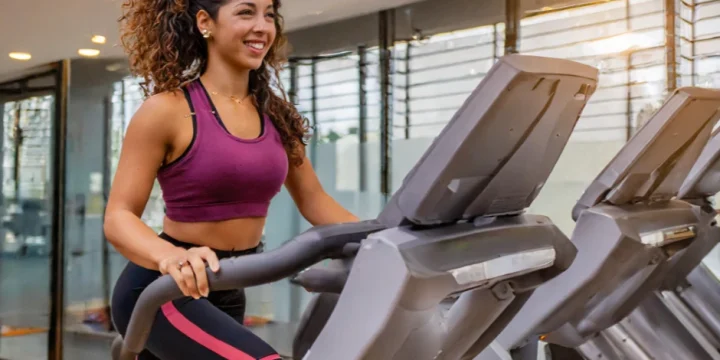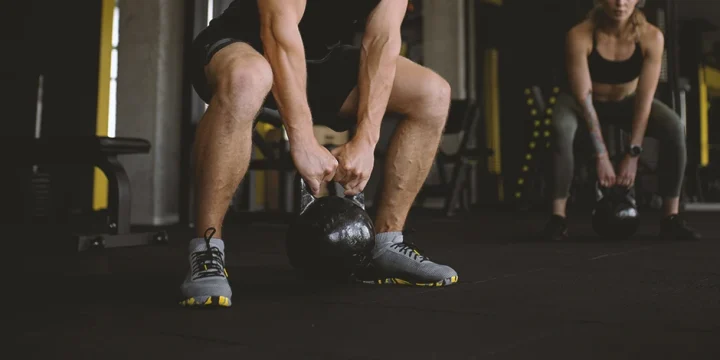If you want to torch more calories and achieve your fitness goals within a short amount of time, why not up your treadmill game with high-intensity interval training?
And HIIT workouts are also another way to make your treadmill session a lot more fun!
So, I dug deep into research to give you this complete guide on how you can start your HIIT treadmill sessions. Let’s go!
Quick Summary
- The eight best HIIT treadmill workouts include The 60-second sprint, Keep-focused workout, Lateral-walking workout, Beginner’s RPE run, No flat-ground workout, Get-it-done-in-20 treadmill workout, Hopping on-and-off-the-treadmill workout, and Tabata training workout.
- One effective HIIT treadmill workout is the 60-second sprint, alternating between one-minute sprints and steady-state pace, which improves muscle strength and anaerobic endurance.
- A study by the NIH found that focusing on muscle activation during exercises like bench presses can increase muscle activity by up to 60%.
- In my view, HIIT treadmill workouts are an excellent choice for those seeking a time-efficient, calorie-burning exercise routine that also adds variety and challenge to traditional treadmill sessions.
What is a High-Intensity Interval Training Treadmill Workout?

High-intensity interval training is alternating exercises of quick and intense workouts followed by less-intense exercises or short rests.
Speed up your HIIT treadmill workout, raise the incline, or mix both for a challenging session, targeting 85-90% of your max heart rate (220 minus your age).
For example, at 25 years old, aim for a heart rate between 166 and 176 during HIIT.
HIIT treadmill runs, with their intense intervals, outperform steady-paced runs in burning calories and fat loss.
Regardless of fitness level, tailor your HIIT treadmill workouts to avoid burnout, starting easy and gradually ramping up intensity if you're new to HIIT.
8 HIIT Treadmill Workouts You Can Try
Here are some HIIT treadmill workouts you can try.
1. The 60-Second Sprint
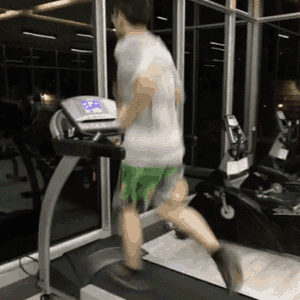
In this HIIT treadmill workout I guide my clients through, we do one-minute sprints. It's an excellent workout for boosting muscle strength, improving stride frequency, and enhancing anaerobic endurance.
I advise to find solid speed – a pace you can maintain steadily for 25 to 30 minutes – and then aim to match or exceed this speed by 2mph during sprints.
- Warm-up (walk or jog): 5 minutes
- Steady-state easy pace: 1 minute
- Sprint: 1 minute
- Alternate steady-state pace and sprint: Repeat minute intervals 6 to 10 times
- Cooldown (walk or jog): 5 minutes
2. Keep-Focused Workout
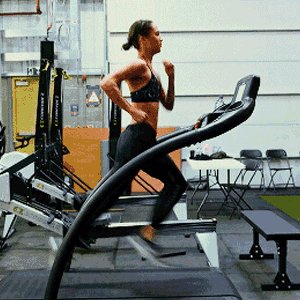
Research indicates that a muscle-mind connection, where you consciously feel the muscle throughout its motion, boosts muscle activity.
One study by the National Institute of Health (NIH), found focusing on muscle activation during a bench press can increase triceps and upper chest activity by up to 60% [1].
Thus, engaging your mind is key to maximizing your HIIT treadmill workout, helping you adapt to varying speeds and inclines.
- Warm-up walking between 2.5 and 3.5 mph: 5 minutes
- Stride (take long steps that's between a jog and a sprint) at 4 to 7 mph: 1 minute
- Walk at 3.0 to 3.5 mph at 5% incline: 3 minutes
- Stride at 4.0 to 7 mph at 5% incline: 1 minute
- Walk at 3.0 to 3.5 mph at 8% incline: 3 minutes
- Stride at 4.0 to 7 mph at 8% incline: 1 minute
- Cooldown (Walk or jog at 3.0 to 3.5 mph) at 1% incline: 5 minutes
3. Lateral-walking Workout
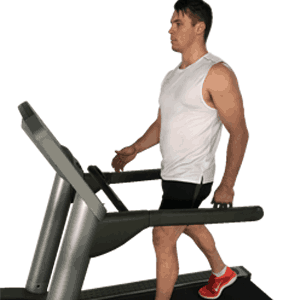
In my experience as a personal trainer, I've found that this low-speed, walking-only HIIT workout, though it appears easy, can actually be quite challenging.
It effectively targets the glutes, increases heart rate, and improves balance.
When guiding clients through lateral walking, I recommend lightly touching the rails for balance but advise against leaning on them.
I instruct them to point their feet sideways, not forward, and to shuffle or cross their feet at a pace that feels comfortable.
- Warm-up (slowly increase speed from 2.4 mph to 3.5 mph): 5 minutes
- Walk laterally at 2.2 mph: 2 minutes (1 minute facing right, 1 minute facing left)
- Walk laterally at 2.4 mph: 2 minutes (1 minute right, 1 minute left)
- Forward walk at 4.5 mph: 1 minute
- Forward walk at 3.5 mph: 1 minute
- Walk laterally at 2.6 mph: 2 minutes (1 minute right, 1 minute left)
- Walk laterally at 2.8 mph: 2 minutes (1 minute right, 1 minute left)
- Forward walk at 4.2 mph: 1 minute
- Forward walk at 3.5 mph: 1 minute
- Walk laterally at 2 mph and 5% incline: 2 minutes (1 minute right, 1 minute left)
- Cooldown (slowly decrease speed from 3.0 to 1.8 mph): 5 minutes
4. Beginner’s RPE Run
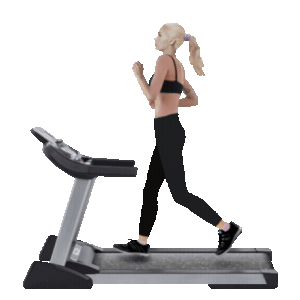
If you’re a beginner on treadmill workouts, here’s a great running workout for you.
This treadmill workout has tons of intervals that allow more room for improvement while also building endurance.
RPE means the rate of perceived exertion.
You can find it indicated in your treadmill, and it is a zero to ten scale of the intensity of your workout.
- Warm-up (dynamic stretches, walk or jog): 5 minutes
- Light run (RPE 6): 90 seconds
- Recovery walk (RPE 3–4): 1 minute
- Run at 3 percent incline (RPE 6–7): 90 seconds
- Recovery walk (RPE 3–4): 1 minute
- Hard run (RPE 8): 90 seconds
- Recovery walk (RPE 3–4): 1 minute
- Hard run (RPE 8–9): 90 seconds
- Recovery walk (RPE 3–4): 2 minutes
- Hard run (RPE 8–9): 90 seconds
- Recovery walk (RPE 3–4): 2 minutes
- Hard run (RPE 8–9): 90 seconds
- Recovery walk (RPE 3–4): 2 minutes
- Run at 3 % incline (RPE 6–7): 2 minutes
- Recovery walk (RPE 3–4): 90 seconds
- Hard run (RPE 7–8): 2 minutes
- Recovery walk (RPE 3–4): 90 seconds
- Breathless run (RPE 8–9): 2 minutes
- Recovery walk (RPE 3–4): 90 seconds
- Sprint (RPE 10): 30 seconds
- Recovery walk (RPE 3–4): 90 seconds
- Sprint (RPE 10): 30 seconds
- Cooldown (walk or jog): 2 minutes
5. No Flat-Ground Workout
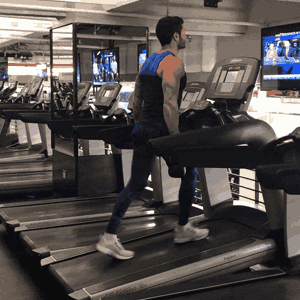
In my training sessions, I often make the treadmill workouts more challenging by adding an incline.
I tell my clients that they don't need to sprint, but the incline itself will make their bodies and hearts work harder, activate their leg muscles more, and boost their aerobic capacity.
- Warm-up Walk (1 minute at 3.0 mph, 2 minutes at 3.5 mph): 3 minutes
- Run at 3.5 mph and 7% incline: 2 minutes
- Run at 4.0 mph and 4% incline: 2 minutes
- Run at 2.8 mph and 10% incline: 2 minutes
- Run at 3.2 mph and 6% incline: 2 minutes
- Run at 3 mph and 8% incline: 2 minutes
- Run at 3 mph and 3% incline: 1 minute
Running intervals at 5% incline for 7 minutes:
- 1 minute at 6.5 mph
- 1 minute at 3.5 mph
- 2 minutes at 6 mph
- 2 minutes at 4 mph
- 1 minute at 3.2 mph
Endurance intervals at 3.2 mph for 11 minutes:
- 3 minutes at 15% incline
- 1 minute at 1%
- 3 minutes at 10%
- 1 minute at 2%
- 3 minutes at 12
Cooldown:
- Walk or jog at 2.8 mph at 3% incline: 2 minutes
- Walk or jog at 2 mph at 1% incline: 1 minute
6. Get-It-Done-In-20 Treadmill Workout
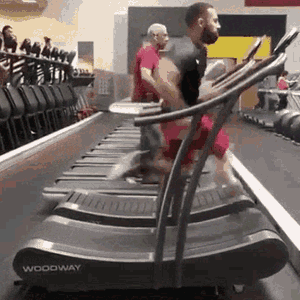
If you only have 20 minutes to spare twice or thrice a week, here's a HIIT treadmill exercise you can get started. This will help increase your cardio endurance and help you burn calories.
You can adjust the speeds based on your heart rate and experience level.
- Warm-up walk at 3.0 mph: 1-2 minutes
- Fast jog at 7.0 to 9.0 mph: 30 seconds
- Walk slowly at 3.0 mph: 1 minute
- Alternate between these intervals for 20 minutes
- Cooldown (walk at 3.0 mph): 2 minutes
7. Hopping On-and-Off-the-Treadmill Workout

I encourage clients to make their treadmill workouts more enjoyable by interspersing them with full-body strength exercises.
Alternating between running and strength training keeps the heart engaged throughout the workout.
It provides you cardiovascular benefits, plus it works your other muscles such as your arms and core.
- Warm-up (Walk or jog at a comfortable space): 5 to 10 minutes
- Run at fast speed: 60 seconds
- Kettlebell swings: 30 seconds
- Push-ups: 30 seconds
- Plank: 60 seconds
- Run at an easy pace: 60 seconds
- Repeat four to six times
- Cooldown (Walk or jog at a gradually slowing down pace): 5 minutes
8. Tabata Training Workout

Try this intense Tabata HIIT treadmill workout, pushing you to your limits.
Tabata, tougher than most HIIT routines, boosts your heart rate into anaerobic zones, working all energy systems.
It involves 20 seconds of high-intensity exercise, followed by 10 seconds rest, repeated eight times over four minutes.
- Warm-up (walk or light jog): 4 minutes
- Run at 2% incline: 5 minutes
- Walk at no incline: 90 seconds
4-minute Tabata interval:
- Run at your maximum speed: 20 seconds
- Rest by hopping onto the sides of the treadmill: 10 seconds
- Repeat for 8 total rounds
- Walk: 90 seconds
- Run at 2% incline: 3 minutes
- Walk: 90 seconds
- Sprint at 4% incline: 2 minutes
- Walk: 90 seconds
- Sprint at no incline: 1 minute
- Cooldown (walk or light jog): 3 minutes
Benefits of HIIT Treadmill Workouts

A study from the National Library of Medicine shows that high-intensity interval training is not better than steady-state exercise, though you have to work longer with steady-state cardio [2].
Though both exercises can give you the same benefits, HIIT provides some advantages over low-intensity cardio. Here are some of them.
Saves You Time
Doing HIIT training is time-efficient and could typically take 15 to 30 minutes, including the warm-up, HIIT intervals, and recovery time. So, if you don't have much time to spend on regular exercise, HIIT works for you.
Helps You Burn Calories Quickly
One study by NIH shows that people who performed HIIT burned 25 to 30% more calories in a short amount of time than those who did weight training, running, and biking [3].
You also torch calories even after you workout with HIIT because it heightens your body’s recovery pace or repair cycle. So, if you're seeking a way to torch calories, increase fat loss, and lose weight fast, try HIIT.
Related Articles:
Boost Your Cardio And Aerobic Gains
HIIT also helps boost one’s cardiovascular fitness – how well the lungs, heart, and muscles work together during prolonged physical activity. Other health benefits of HIIT include reducing heart rate, blood pressure, and body fat.
“When one is aerobically fit, their heart can pump blood better, it takes longer for them to get out of breath, and so, the farther and faster they’re able to bike or run or swim.”
- Martin Gibala, Interval Training Expert, McMaster University, Canada
Pushes You Out Of Your Comfort Zone
HIIT training is a pretty challenging workout that gets you out of a comfortable pace. With HIIT, you're taking your cardio workouts on a higher level so that they can get uncomfortable, but if you’re all-out, the benefits outweigh the costs.
Injury Prevention and Recovery
High-Intensity Interval Training (HIIT) on treadmills can be effective but poses injury risks.
- To prevent injuries, start with a proper warm-up, including dynamic stretches and a light jog, to increase blood flow and prepare muscles.
- Choose footwear with adequate support and cushioning tailored for high-impact activities.
- During workouts, maintain proper form, focusing on foot alignment and avoiding overstriding.
- Post-workout, engage in cool-down stretches targeting legs and lower back to enhance flexibility and reduce muscle tension.
- For recovery from common injuries like shin splints or runner's knee, rest is crucial.
- Apply ice to reduce inflammation and consider physiotherapy exercises to strengthen related muscles.
- Always consult a healthcare professional for persistent pain or discomfort.
FAQs
Are 20 Minutes of HIIT a Day Enough?
Yes, HIIT workouts are performed in a shorter amount of about 15 to 30 minutes than other upper body exercises. But, avoid doing HIIT exercises every day because it could result in fatigue or injury.
How Much Do 30 Mins of HIIT Burn?
Studies show that a 30-min HIIT session could burn up to 450 calories. With HIIT, you’re burning huge amounts of calories in much shorter periods.
What Is the Best Hiit Workout on a Treadmill?
One of the most effective HIIT treadmill workouts involves a structured interval routine. It starts with a 5-minute warm-up followed by 30-second sprints and 30-second rests, repeated for 15-20 minutes. The key is to adjust speed and incline according to your fitness level, ensuring a challenging yet manageable workout that maximizes fat burning and cardiovascular benefits.
References:
- https://pubmed.ncbi.nlm.nih.gov/26700744/
- https://www.ncbi.nlm.nih.gov/pmc/articles/PMC4657417/
- https://pubmed.ncbi.nlm.nih.gov/25162652/
About The Author
You May Also Like
